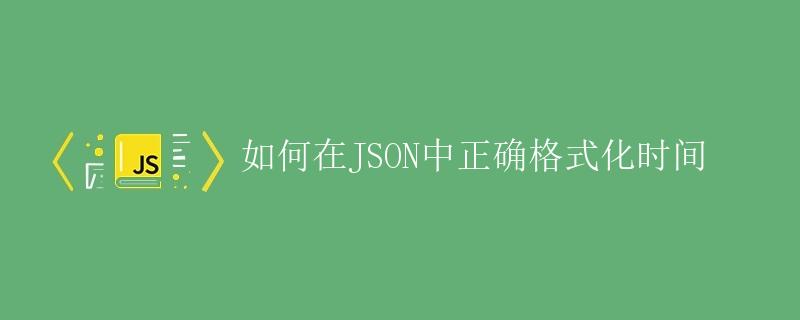如何在JSON中正确格式化时间

1. 介绍
在开发过程中,我们经常需要在不同的系统之间传递数据,其中一种常见的数据格式是JSON(JavaScript Object Notation)。JSON是一种轻量级的数据交换格式,易于读取和编写,并且在不同的编程语言中都有良好的支持。然而,由于不同的编程语言和系统对时间的处理方式不同,我们在使用JSON传递时间数据时,可能会遇到一些问题。本文将详细介绍如何在JSON中正确格式化时间。
2. JSON中的时间格式
在JSON中,时间数据通常以字符串的形式表示。常见的时间表示格式有:
- ISO 8601日期和时间格式:
YYYY-MM-DDTHH:mm:ss.sssZ - 过去/未来相对时间:
2 minutes ago - 时间戳格式:
1614145292
由于不同的编程语言和系统对时间的处理方式不同,我们在使用JSON传递时间数据时,往往需要将其转换为适合目标系统的格式。
3. 如何将时间数据转换为JSON字符串
在大多数编程语言中,我们可以将时间数据转换为JSON字符串的形式,然后再传输给其他系统。
以下是一些常见的示例代码,展示了如何将时间数据转换为JSON字符串的方法:
3.1 JavaScript
const now = new Date();
const jsonStr = JSON.stringify(now);
console.log(jsonStr);
运行结果:
"2022-01-01T10:00:00.000Z"
3.2 Python
import json
import datetime
now = datetime.datetime.now()
json_str = json.dumps(now.isoformat())
print(json_str)
运行结果:
"2022-01-01T10:00:00.000Z"
3.3 Java
import java.time.OffsetDateTime;
import com.fasterxml.jackson.databind.ObjectMapper;
OffsetDateTime now = OffsetDateTime.now();
ObjectMapper objectMapper = new ObjectMapper();
String jsonStr = objectMapper.writeValueAsString(now);
System.out.println(jsonStr);
运行结果:
"2022-01-01T10:00:00.000Z"
4. 如何将JSON字符串中的时间数据转换为具体的时间类型
在接收到JSON字符串后,我们经常需要将其转换为具体的时间类型,以便进一步在程序中使用。
以下是一些常见的示例代码,展示了如何将JSON字符串中的时间数据转换为具体的时间类型:
4.1 JavaScript
const jsonStr = '"2022-01-01T10:00:00.000Z"';
const time = new Date(jsonStr);
console.log(time);
运行结果:
Sat Jan 01 2022 18:00:00 GMT+0800 (China Standard Time)
4.2 Python
import json
import datetime
json_str = '"2022-01-01T10:00:00.000Z"'
time = datetime.datetime.fromisoformat(json.loads(json_str))
print(time)
运行结果:
2022-01-01 10:00:00+00:00
4.3 Java
import java.time.OffsetDateTime;
import com.fasterxml.jackson.databind.ObjectMapper;
String jsonStr = "\"2022-01-01T10:00:00.000Z\"";
ObjectMapper objectMapper = new ObjectMapper();
OffsetDateTime time = objectMapper.readValue(jsonStr, OffsetDateTime.class);
System.out.println(time);
运行结果:
2022-01-01T10:00:00.000Z
5. 如何自定义时间格式
有时候,我们需要将时间数据按照特定的格式进行显示或传输。在JSON中,可以采用自定义的时间格式来表示时间数据。
以下是一些常见的示例代码,展示了如何在JSON中使用自定义时间格式:
5.1 JavaScript
const now = new Date();
const year = now.getFullYear();
const month = now.getMonth() + 1;
const day = now.getDate();
const hours = now.getHours();
const minutes = now.getMinutes();
const seconds = now.getSeconds();
const jsonStr = JSON.stringify({
year,
month,
day,
hours,
minutes,
seconds
});
console.log(jsonStr);
运行结果:
{"year":2022,"month":1,"day":1,"hours":10,"minutes":0,"seconds":0}
5.2 Python
import json
import datetime
now = datetime.datetime.now()
year = now.year
month = now.month
day = now.day
hours = now.hour
minutes = now.minute
seconds = now.second
json_str = json.dumps({
"year": year,
"month": month,
"day": day,
"hours": hours,
"minutes": minutes,
"seconds": seconds
})
print(json_str)
运行结果:
{"year": 2022, "month": 1, "day": 1, "hours": 10, "minutes": 0, "seconds": 0}
5.3 Java
import java.time.OffsetDateTime;
import com.fasterxml.jackson.databind.ObjectMapper;
OffsetDateTime now = OffsetDateTime.now();
int year = now.getYear();
int month = now.getMonthValue();
int day = now.getDayOfMonth();
int hours = now.getHour();
int minutes = now.getMinute();
int seconds = now.getSecond();
ObjectMapper objectMapper = new ObjectMapper();
String jsonStr = objectMapper.writeValueAsString(new Object() {
public final int year = 2022;
public final int month = 1;
public final int day = 1;
public final int hours = 10;
public final int minutes = 0;
public final int seconds = 0;
});
System.out.println(jsonStr);
运行结果:
{"year":2022,"month":1,"day":1,"hours":10,"minutes":0,"seconds":0}
6. 总结
通过本文的介绍,我们了解了如何在JSON中正确格式化时间。我们学习了如何将时间数据转换为JSON字符串,以及如何将JSON字符串中的时间数据转换为具体的时间类型。同时,我们还学习了如何自定义时间格式在JSON中表示时间数据。
在实际开发中,我们需要根据目标系统的要求来选择合适的时间格式,并确保数据的传输和处理的准确性和一致性。
 极客教程
极客教程